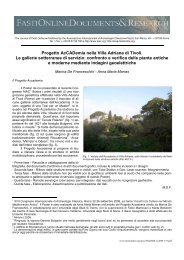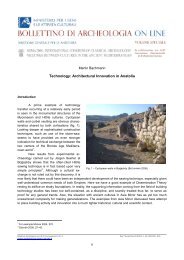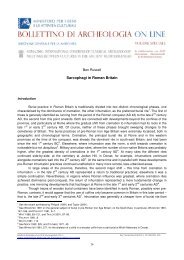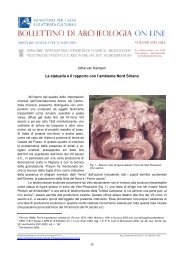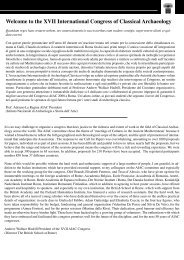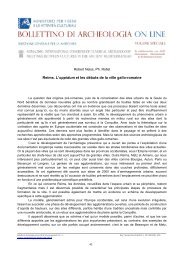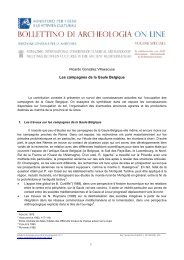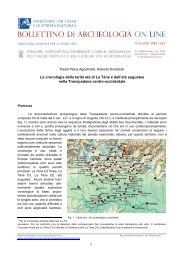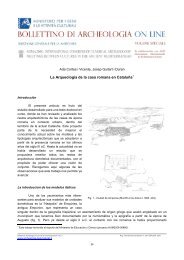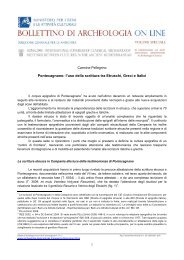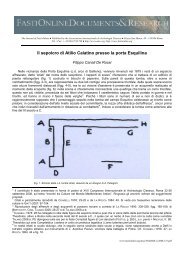The Architecture of the Jupiter Sanctuary in Baalbek / Heliopolis
The Architecture of the Jupiter Sanctuary in Baalbek / Heliopolis
The Architecture of the Jupiter Sanctuary in Baalbek / Heliopolis
You also want an ePaper? Increase the reach of your titles
YUMPU automatically turns print PDFs into web optimized ePapers that Google loves.
D. Lohmann – Giant Strides towards Monumentality - <strong>The</strong> <strong>Architecture</strong> <strong>of</strong> <strong>the</strong> <strong>Jupiter</strong> <strong>Sanctuary</strong> <strong>in</strong> <strong>Baalbek</strong> / <strong>Heliopolis</strong><br />
Fig. 1 - <strong>The</strong> <strong>Jupiter</strong> Heliopolitanus <strong>Sanctuary</strong> <strong>in</strong> <strong>Baalbek</strong>/ <strong>Heliopolis</strong>. Floor Plan (Draw<strong>in</strong>g: Lohmann. Adapted from WIEGAND 1921,<br />
Kalayan (Archives, Direction Générale des Antiquités Beirut).<br />
Development <strong>of</strong> a sanctuary (fig. 1)<br />
Newest archaeological results from a previously unpublished deep trench <strong>of</strong> pre-civil war<br />
excavations <strong>of</strong> <strong>the</strong> Lebanese antiquities department <strong>in</strong> <strong>the</strong> central Great Courtyard show that Tell <strong>Baalbek</strong>,<br />
even though it can be considered ra<strong>the</strong>r marg<strong>in</strong>al <strong>in</strong> size, was cont<strong>in</strong>uously <strong>in</strong>habited s<strong>in</strong>ce <strong>the</strong> pre-pottery<br />
Neolithic period. 5 Geographic advantages <strong>of</strong> this exposed position, controll<strong>in</strong>g two fresh water spr<strong>in</strong>gs which<br />
supply <strong>the</strong> fertile nor<strong>the</strong>rn Bekaa pla<strong>in</strong>, may have been <strong>the</strong> reason for <strong>the</strong> early settlers to <strong>in</strong>habit a natural<br />
rock spur <strong>in</strong> front <strong>of</strong> <strong>the</strong> valleys mouth, slightly elevated above <strong>the</strong> surround<strong>in</strong>g area. 6 <strong>The</strong> Tell grew and was<br />
cont<strong>in</strong>uously occupied by dwellers and possibly cultic functions until at least Iron Age. It appears that some<br />
time after this period <strong>the</strong> dwellers were forced to move <strong>in</strong>to <strong>the</strong> pla<strong>in</strong> or <strong>the</strong> hill slopes around, when <strong>the</strong><br />
entire artificial platform <strong>of</strong> <strong>the</strong> Tell was architecturalized with a purely cultic sanctuary. This happened several<br />
times, with <strong>the</strong> new construction enclos<strong>in</strong>g <strong>the</strong> old.<br />
Rema<strong>in</strong>s <strong>of</strong> pre-Roman monumental construction were found <strong>in</strong> excavations under <strong>the</strong> Roman floor<br />
level <strong>of</strong> <strong>the</strong> Great Courtyard <strong>in</strong> <strong>the</strong> time <strong>of</strong> French and Lebanese works <strong>in</strong> <strong>Baalbek</strong> 7 . Current survey and<br />
<strong>in</strong>terpretation show, that a pre-Roman floor level about 5m lower than <strong>the</strong> late Roman Great Courtyard floor<br />
existed underneath <strong>the</strong> later eastern courtyard. <strong>The</strong> features <strong>in</strong>clude a freestand<strong>in</strong>g podium monument, and<br />
an earlier stair flight, both suggest<strong>in</strong>g an earlier sanctuary entrance.<br />
Fur<strong>the</strong>rmore, <strong>the</strong> foundation wall underneath <strong>the</strong> peristasis <strong>of</strong> <strong>the</strong> early imperial pseudodipteral<br />
temple could be proven to be <strong>of</strong> pre-Roman date. This formerly T-shaped terrace was already a gigantic<br />
construction, at least five meters higher than <strong>the</strong> Tell and any platform construction. Due to <strong>the</strong> lack <strong>of</strong> rema<strong>in</strong>s<br />
5<br />
Van Ess ET ALII 2008. Even <strong>the</strong> particular time <strong>of</strong> excavation and <strong>the</strong> reason for <strong>the</strong> deep trench are unclear. However, it provides<br />
archaeological material prov<strong>in</strong>g <strong>the</strong> existence and a prelim<strong>in</strong>ary dat<strong>in</strong>g <strong>of</strong> “Tell <strong>Baalbek</strong>”.<br />
6<br />
RHEIDT 2008, 222. <strong>The</strong> existence <strong>of</strong> this rock spur underneath <strong>the</strong> sanctuary and <strong>the</strong> Tell was proven by geoelectrical resistancy<br />
measurements <strong>in</strong> <strong>the</strong> spr<strong>in</strong>g <strong>of</strong> 2008. BRAUNS 2008, 42–49; BAATZ 2008, 37–44.<br />
7<br />
Only few publications mention <strong>the</strong>se rema<strong>in</strong>s, none <strong>of</strong> <strong>the</strong>m clearly analyz<strong>in</strong>g <strong>the</strong>m. KALAYAN 1969, 153. See also RAGETTE 1980, 27.<br />
Bollett<strong>in</strong>o di Archeologia on l<strong>in</strong>e I 2010/ Volume speciale/ Poster Session 2 Reg. Tribunale Roma 05.08.2010 n. 330 ISSN 2039 - 0076<br />
www.archeologia.beniculturali.it/pages/pubblicazioni.html<br />
29



